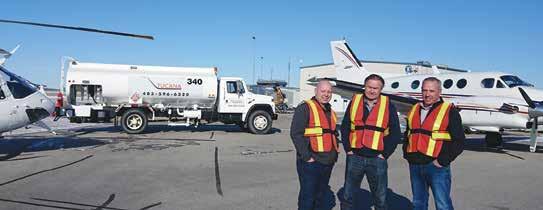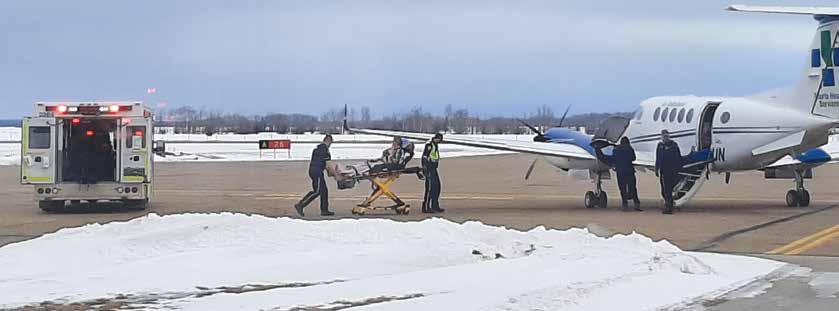
13 minute read
A one-stop shop: Red Deer Regional Airport converts ter inal into FBO
A one-stop shop
By Shayna Wiwierski
Construction started in November 2019 to turn the existing terminal at the Red Deer Regional Airport into a full-service Fixed-Based Operator (FBO), in partnership with Tucana Aviation.
Red Deer Regional Airport recently made changes to its terminal after Air Canada ceased service in 2018.
Construction started in November 2019 to turn the existing terminal at the Red Deer Regional Airport into a full-service Fixed-Based Operator (FBO), in partnership with Tucana Aviation. Since the airport was home to mainly flight training schools and charter flights in support of the oil patch, a decision was made to focus on growing this business, while at the same time providing a better level of service for its existing customers. As a result, they entered into a partnership agreement with Tucana Aviation, a local Red Deer company that has experience operating FBOs, and with that, the contacts necessary to help grow the airport charter business.
“That was part of our business development strategy,” says Graham Ingham, CEO of the Red Deer Regional Airport. “We chose Tucana for several

The FBO at the airport will provide support in the form of fueling, deicing, maintenance, catering, transportation/accommodation logistics, and more.
reasons, with the primary being that they already had a business presence at the airport, and therefore already significantly invested from a business perspective. Additionally, they understood that for this venture to be successful, they would need to invest some of their own money. That’s always a win-win; anytime you can help existing tenants expand their business, that’s something we look upon favourably.”
The FBO at the airport will provide support in the form of fueling, deicing, maintenance, catering, transportation/ accommodation logistics, and more. The renovation was completed in the first week of December and included new flooring, a new ceiling, a private flight crew lounge, and a general overall facelift to the building, which was built in the 1970s.
Ingham says that the response from carriers that have been using the FBO has been positive and that they like the fact that they have only one person to call for all their needs.
“They like being able to get ahold of somebody 24/7,” says Ingham. “They appreciate the increased focus on customer service and no longer feel their business is being taken for granted.”
The upgrades cost about $115,000 and Budal Construction out of Red Deer were the general contractors on the project.
Since this is the only terminal the airport has, they are looking to build a second one in the next few years to support bigger aircraft.
This project is one of many things that the Red Deer Regional Airport has planned for the future of the airport. Ingham says that they are heavily focused on land development right now with two land development projects currently in the works, one of which has the potential to add $2.4 million in lease revenue and more than 500 local jobs to the community. He also hopes that in the future they will land a large tenant, as well as scheduled service to support upgrades to their existing runway/taxiways, approaching lighting, and more.
The FBO was just the first step in bringing more traffic to the business.
The renovation was completed in the first week of December 2019 and included new flooring, a new ceiling, a private flight crew lounge, and a general overall facelift to the building, which was built in the 1970s.

The upgrades to the terminal cost about $115,000 and Budal Construction out of Red Deer were the general contractors on the project.

“From the airport’s perspective, this was an opportunity to work with Tucana Aviation to drive more traffic to the airport. Anytime they are going to bring more traffic to the airport, that means an increase in revenue,” says Ingham. “Concerning the community, obviously the more traffic you can drive to the airport, the more opportunity there will be for smaller businesses such as restaurants, hotels, and rental car agencies to thrive and prosper.”
Tucana Aviation terminal grand opening celebration at the Red Deer Airport.

White out
Air ambulances facing challenges getting into smaller airports during the winter

By Shayna Wiwierski
Winter time in Alberta can be rough. Since the province has over 4.3 million residents, many of which live in smaller rural communities, it is important to have medical services that can reach these municipalities.
AHS Air Ambulance flies to many regions in the province and air-transports residents to nearby hospitals. A lot of times lives really are at risk in these situations and having access to air ambulances really is the difference between life and death.
“Air ambulance safety is paramount to Alberta Health Services. Our air ambulance operation relies on accurate and timely runway maintenance and condition reporting in order to safely land and take off. In Alberta, municipalities are responsible for airport maintenance, infrastructure and runway condition reporting. AHS works continuously with our airport partners to ensure continued aviation safety,” says Alberta Health Services in a written statement.
In the winter time, because of the snow and ice, as well as temperatures that can go from really cold to mild weather in the span of a few hours, that can often create a problem and a hazard for aircrafts, including medevacs and air ambulances.
So, what happens when winter conditions affect the arrival of these aircrafts?
James Ogilvie is the airport manager at the Whitecourt Airport and says that some of the main issues for smaller airports in the province is that they aren’t Transport Canada certified so they don’t have a way to report the conditions on their air strips. The Whitecourt Airport is certified so they have to issue a Runway Surface Condition (RSC) report, which they do first thing in the morning, and depending on the weather, several times throughout the day. The RSC helps pilots know what kind of weather they are flying into.
“The fact that these small airports don’t have anyone who can issue a condition report [is a problem],” says Ogilvie. “With small, local airports, some are registered, some are not, some have people that maintain them and some have people that, you know, cut the grass once a year or plow the snow once a year kind of thing.” Ogilvie says that in the summer months, landing an air ambulance isn’t an issue, even in the rain. In the winter time, because of the snow and ice, as well as temperatures that can go from really cold to mild weather in the span of a few hours, that can often create a problem and a hazard for aircraft. In Whitecourt, they haven’t had any issues so far, however, Ogilvie does mention that lack of funding for smaller, municipalityowned airports is definitely a big issue when it comes to this concern.
Kenneth Launchbury, airport operator/ safety assistance for the County of Northern Lights, says that at the Manning Airport they mostly have medevacs and fire suppression teams coming into their airport. He says that sometimes the medevacs have a hard time landing in Manning due to weather and thinks that with more funding they would be able to keep the runways open longer.
The Alberta Health Services air ambulance operation relies on accurate and timely runway maintenance and condition reporting in order to safely land and take off.

not having the funding available [can be a detriment to operations],” says Launchbury. “We have in the past had to turn away some of those [medevacs], which means an extra hour in an ambulance to get to Peace River.”
They have an on-call number in Whitecourt, so if the air ambulances want to arrive in the middle of the night, they are able to call the airport and receive an RSC report. Ogilvie says that although he hasn’t had any issues with getting air ambulances into the Whitecourt airport, when he worked in Fort Nelson running their airport, they would have to call in employees to clear the runways of snow if there was a call late at night. The community was prepared for that cost, but there are many communities and hamlets that aren’t able to handle the cost of having additional staff come in unexpected for a few hours.
“It comes down to the community where the airports are at and if anybody is there. This group of air ambulance people and staff, they do their best to get into these communities and sometimes they just can’t because they can’t fly into something that is unknown,” says Ogilvie. “There are so many factors when you look at these kinds of things. In some cases you have to say ‘look, we can’t get in there, sorry.’ So the community has to figure out a way to transport from wherever they are to a place where they can get into a medevac.”
fly with Us
Look at what Dawson Creek Regional Airport has to offer:

• Convenient Location • WIFI Internet Connection • No Parking or Airport User Fees • Competitive Terminal and Landing Fees • Fully Functional Pilots Lounge 24/7 • Extra flights with more convenient flight times
For flight times or reservations contact your travel agent or call direct:
Money to aintain
By Shayna Wiwierski
The Whitecourt Airport, like many regional Alberta airports, is funded by the rural municipality of Woodlands County. Since their scheduled service stopped in October 2018, and they are ineligible to receive ACAP funding.

Regional, municipal-owned airports in Alberta continue to struggle with funding. The province of Alberta is currently home to over 150 airports, including local airstrips, community airports, regional airports, and international airports. Unlike the province’s two major airports in Calgary and Edmonton, many of these facilities don’t receive regular funding by the provincial and federal governments to operate, making it difficult to often run and maintain these facilities.
Transport Canada does offer the Airports Capital Assistance Program (ACAP), which has been funding improvement projects for regional airports since 1995. The program, to date, has invested more than $785.9 million for 904 projects at 182 airports, however, those airports must be able to provide scheduled and charter air services that link communities to regional, national, and international markets for goods and services.
“So long as you have a scheduled service and are moving more than 1,000 passengers a year, you can apply to Transport Canada for ACAP funding,” says James Ogilvie, airport manager at the Whitecourt Airport. “Unfortunately our scheduled service stopped in October 2018, and we are ineligible to receive ACAP funding. It’s a very small pot of money [ACAP] and a very large amount of subscription for funding.”
general aviation, charters, forestry, and oil and gas sectors, as well as medevacs. The airport, like many regional Alberta airports, is funded by the rural municipality of Woodlands County. Ogilvie says they just started charging landing fees so their revenue will go up somewhat, but they currently run at a deficit. At present, their yearly budget to run the airport is around $900,000.
“Some charge [landing fees] and others don’t. It’s a question for local council if they want to charge them or not,” says Ogilvie.
The County of Northern Lights currently charges landing fees at their airport in Manning to help offset costs that go above their municipal funding. Kenneth Launchbury, airport operator/safety assistant for the County of Northern Lights, says that they aren’t eligible for federal or provincial funding since they aren’t a certified airport.
The Manning Municipal Airport is able to accommodate general aviation of all aircraft up to Code 3 designation, as well as medevacs and those working in the oil and gas industry. Launchbury says that they also rent out a portion of their land to the forestry industry and have some tenants that help to offset some of their costs. They charge landing fees for commercial aircraft that land at their airport, as well as private aircraft over 2,500 kilograms.
Launchbury says that the landing fees do help with the maintenance of the airport. Since they are so remote they do get a lot of medevacs that use the airport, and provincial and federal funding would definitely help them keep their runways clear, especially in the winter months where snow and ice tend to build up.
“I think because we offer the medevacs and fire and whatnot, we shouldn’t be overlooked just because we don’t have scheduled services,” says Launchbury. “Especially in smaller areas that take a lot longer to get anywhere in an ambulance and lives could potentially be at stake, to have that funding would give the potential of keeping our doors open in bad weather.”
Although municipal airports may not be eligible for ACAP funding, there are other grants available. One of them is the Strategic Transportation Infrastructure Program (STIP), which offers the Community Airport Program (CAP). The goal of this program is to maintain the existing network of public-use community airports to support safe airport operations, general aviation operations, commercial air charters, forest fire suppression, medevac operations, local and regional economic development, and provincial investment in airports. Airports applying for STIP funding must meet a set number of requirements and eligible applicants include municipalities that own/operate community-owned, public-use airports.
Lac La Biche airport received a STIP grant in 2019 to install new approach light which are LED into the airport, however, the grant only covered approximately 55 per cent of the bid price. Like Manning and Whitecourt, Lac La Biche County also relies on taxpayer dollars to fund their airport, as well as lease revenue.
“We get approximately 60 per cent of our funding from lease revenue with the hangers we have on site,” says Barry Feledichuk, supervisor at Lac La Biche County. “Our lease rates are 55 to 77 cents a square metre and that covers 50 to 60 per cent. The rest is subsidized by municipal revenues.”
Feledichuk says that, like their other provincial counterparts, they also run at a deficit and although they don’t charge landing fees, it is a topic that they have discussed numerous times over the years. He adds that there are other grants out there that they would be eligible for, but there is so much competition for those grants that it’s hard to get approved for the funding.
“Everybody wants to improve their airport and there’s only so much money to go around,” he says. “We are fortunate in Lac La Biche County that we have an understanding council, and although there isn’t a lot of provincial or federal money out there, we are still blazing away. We are still willing to keep our airport open for business. There’s a lot of spin offs involved with an airport that people don’t understand.”
DEL Communications Inc. and you, THE KEYTO SUCCESS .



We offer outstanding personal service and quality in the areas of: CREATIVE DESIGN | ADVERTISING SALES TRADE PUBLICATIONS | QUALIFIED SALES & EDITORIAL TEAM
Suite 300, 6 Roslyn Road, Winnipeg, Manitoba, Canada R3L 0G5 Toll Free:1 .866.831 .4744 | Toll Free Fax: 1 .866.71 1 .5282 www.delcommunications.com







